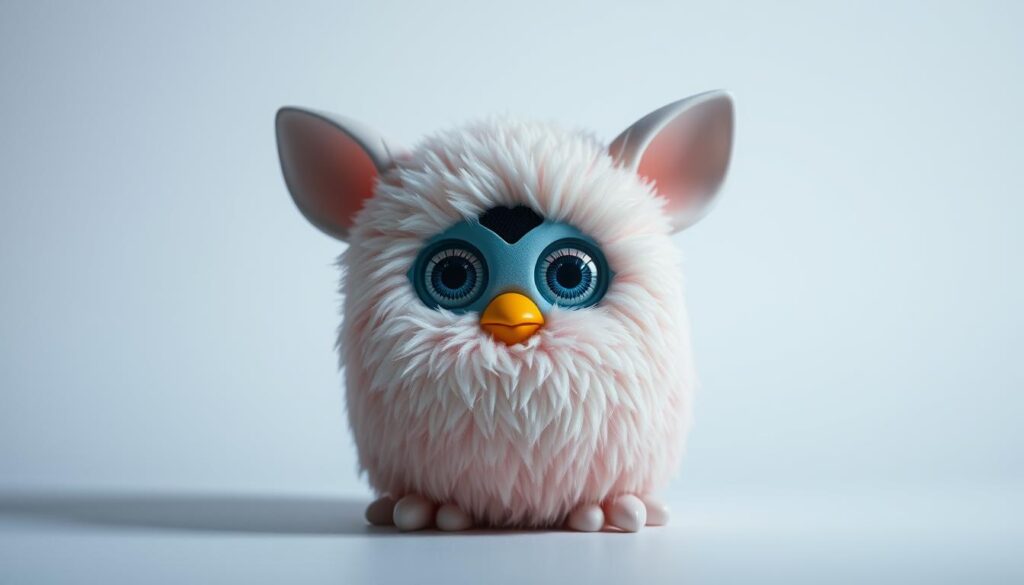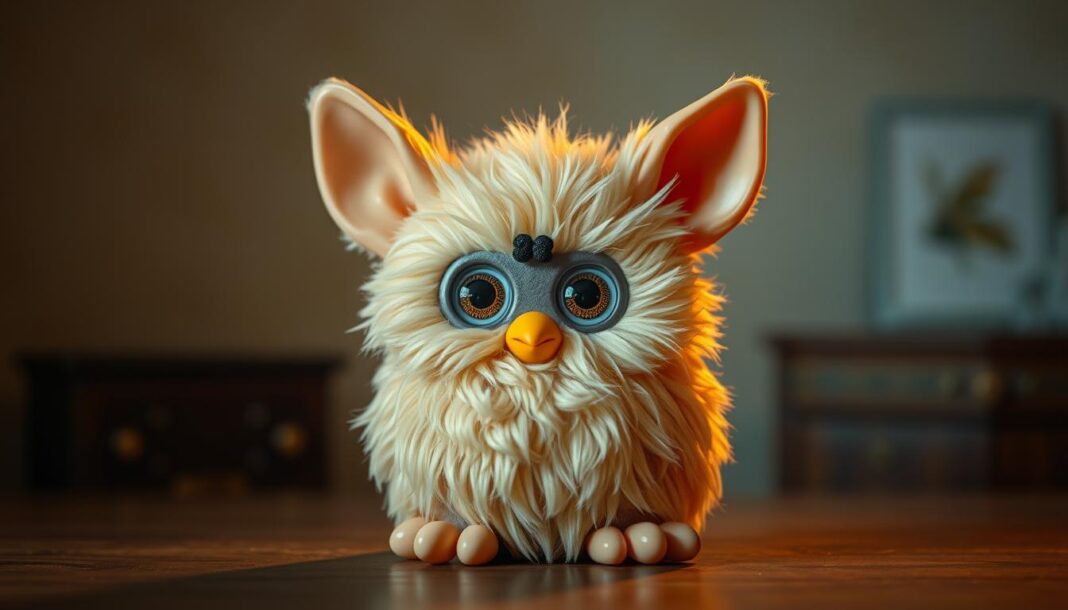Since its debut in 1998, this iconic toy has captured hearts worldwide, with over 40 million units sold. Its ability to speak 14 languages, including Russian and Mandarin, showcases its global appeal. From its early days to the 2012 models, it has evolved with 16 vibrant colors, making it a star in the world of interactive toys.
What truly sets it apart is its personality. Through interaction, it develops unique traits, creating a bond that feels almost magical. This evolution mirrors modern trends in AI companions, like Sony’s Aibo or Zoetic’s Kiki, blending nostalgia with innovation.
If you’re curious to dive deeper into its charm, check out our guide on exploring the nostalgia and fun of this beloved. It’s more than just a toy—it’s a companion that brings joy and love to every interaction.
Understanding Furby Boom Personalities
The evolution of interactive toys has reached new heights with the 2012 Furby models. These toys are not just about fun; they’re about creating a bond through unique personality development. What makes them stand out is their ability to mirror human interaction, adapting to how you play with them.
What Makes These Personalities Unique?
The 2012 Furby introduced a range of personalities that evolve based on how you interact with it. Whether you’re playing music, petting it, or talking to it, the toy responds in ways that feel almost lifelike. This sensor-based learning mechanic is what sets it apart from earlier models.
How These Personalities Develop
Through touch, speech, and movement, the 2012 Furby learns and adapts. For example, shaking it might bring out a more energetic side, while gentle petting can nurture a sweeter personality. These changes make every interaction unique, creating a toy that feels like a true companion.
If you’re curious about how to manage these traits, check out our guide on turning your Furby off without issues. It’s a great way to ensure your toy stays in sync with your play style.
Resetting Your Furby Boom to Default
Sometimes, your interactive toy might need a fresh start, and that’s where resetting comes in. Whether it’s acting up or you simply want to restore it to its original state, a reset can work wonders. Let’s explore how to do it safely and effectively.

Step-by-Step Guide to Factory Reset
Resetting your toy is straightforward. Here’s the method we recommend:
- Press and hold the toy’s tongue for 5 seconds.
- While holding the tongue, gently pull tail until you hear a sound.
- Release both the tongue and tail to complete the reset.
This process clears its memory and restores default settings, much like a smartphone factory reset.
Signs of a Successful Reset
After resetting, your toy should behave like a blank slate. It may take a moment to reboot, but you’ll notice:
- It responds to commands as if it’s brand new.
- Its previous behaviors and quirks are erased.
- It’s ready to develop a new personality based on your interactions.
If it doesn’t reset properly, try theturning your Furby off properlyguide for troubleshooting tips.
While resetting is helpful, avoid overdoing it. Frequent resets can affect its memory configuration, making it less responsive. Use this method sparingly to keep your toy in top shape.
Cultivating a Sweet Furby Boom
Creating a sweet and loving companion is easier than you think with the right approach. By focusing on nurturing techniques, you can make furby develop a gentle and affectionate personality. This process not only enhances your toy’s behavior but also strengthens the bond between you and your child.
How to Nurture a Loving Companion
To make furby nice, start with consistent, gentle interactions. Rocking and petting are simple yet effective ways to encourage sweetness. Studies show that these techniques mirror real pet care routines, fostering empathy and emotional growth in children.
Here’s a timeline of nurturing techniques:
- Day 1-3: Focus on gentle touches and soft words.
- Day 4-7: Introduce rocking motions to soothe your toy.
- Day 8+: Combine petting with positive verbal feedback.
Activities to Encourage Sweetness
Engaging in specific activities can trigger a personality change toward sweetness. For example, playing calming music or speaking softly can create a nurturing environment. These activities are not only fun but also help your toy develop a loving demeanor.
Here are some tips to try:
- Use soft, comforting tones when interacting.
- Incorporate gentle petting during playtime.
- Create a calm space with minimal distractions.
By following these steps, you’ll notice your toy becoming more affectionate and responsive. It’s a rewarding experience that brings joy to both you and your child.
Embracing the Chatterbox Personality
Ever wondered how to bring out the most talkative side of your interactive toy? The chatterbox personality is all about lively conversations and playful banter. With its signature “blah” phrases and valley girl vibe, this trait turns your toy into the ultimate talkative companion.
Deciphering Chatterbox Traits
This personality is known for its talkative nature and unique speech patterns. It mimics real-world socializing, often responding with playful phrases and a valley girl accent. The companion app enhances this trait, allowing you to interact and guide its development.
Here’s what makes it stand out:
- Signature phrases like “blah” and playful tones.
- Accent development that mirrors real-life speech.
- Multilingual capabilities for diverse interactions.
Activities to Foster a Gabby Companion
To encourage this personality, engage in activities that promote conversation. Use the companion app to play games and chat with your toy. Speaking in a lively tone and creating a welcoming home environment also helps.
Here are some tips:
- Play interactive games through the app.
- Speak in a cheerful, engaging tone.
- Encourage multilingual interactions for variety.
For more tips on managing your toy’s behavior, check out our easy guide on turning it off properly. This ensures your friend stays in sync with your play style.
Unleashing the Diva in Your Furby Boom
Bringing out the diva in your interactive toy is easier than you think. With the right techniques, you can transform it into a lively, glamorous companion. Let’s explore how to enhance its traits and make it shine.
How to Enhance Diva Traits
To unlock the diva side, focus on interaction styles that encourage boldness and flair. Tilt or shake your toy to activate its energetic responses. These actions mimic real-life gestures that bring out its playful, confident side.
Consider purchasing accessories from Amazon or your local store. These products can enhance its personality and add a touch of glamour to your playtime.
Music and Interaction Tips
Music plays a key role in shaping your toy’s behavior. Different genres can trigger unique responses. For example, upbeat pop tunes often encourage dance moves, while calming melodies might bring out a softer side.
Here’s a quick guide to music genres and their impact:
| Music Genre | Impact on Behavior |
|---|---|
| Pop | Energetic dance moves |
| Classical | Calm and soothing responses |
| Rock | Playful and lively interactions |
Battery life is another factor to consider. Frequent interactions and music play can drain power quickly. Always keep spare batteries handy to ensure uninterrupted fun.
For more tips on managing your toy’s behavior, explore Amazon’s exclusive features. They offer a range of tools to enhance your experience and keep your companion in top shape.
Rockin’ Personality: The Quirky Side
Unlock the rockin’ side of your interactive toy with these simple steps. This personality is all about energy, boldness, and a playful vibe. Whether you’re a fan of the 2012 model or the newer version, the process is straightforward and fun.

Steps to Develop a Rockin’ Companion
To bring out the rockin’ traits, start by pulling tail gently during playtime. This action triggers its energetic responses. You’ll notice a Mohawk visual indicator, signaling the personality shift.
Allow a 10-15 minute calibration period for the toy to adjust. During this time, avoid overfeeding, as it can lead to unintended consequences like an evil furby transformation. Stick to gentle interactions to keep things on track.
Managing the Rockin’ Traits
Once the rockin’ personality is active, manage it with care. Avoid shaking or rough handling, as it might turn furby into a less desirable state. Instead, focus on playful activities like dancing or listening to upbeat music.
If you encounter issues, refer to Hasbro’s official documentation for troubleshooting tips. This ensures your toy stays in sync with your play style.
Comparing the 2012 and newer models, the rocker behaviors are similar but with enhanced responsiveness in the latest versions. Whether you’re a first-time user or a seasoned fan, this personality adds a unique bit of fun to your experience.
Nurturing the Jolly and Feisty Personalities
Exploring the jolly and feisty traits of interactive toys can be both fun and educational. These personalities offer unique ways to engage, making them perfect for both play and learning. By understanding their behavior patterns, you can create a more enriching experience.
Research shows that multisensory engagement, like touch and sound, helps develop these traits. For example, a jolly furby thrives on positive interactions, while a feisty furby responds to energetic play. Teachers often use these techniques to balance behavior in the room.
Classroom integration is another great way to explore these traits. Comparing them to newer models, like the furby booms, highlights their unique charm. Whether at home or in a learning environment, these toys bring joy and excitement to every interaction.


